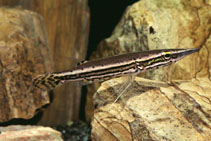http://www.fishbase.org/Summary/speciesSummary.php?genusname=Luciocephalus&speciesname=pulcher ---> http://192.134.151.83/Summary/speciesSummary.php?genusname=Luciocephalus&speciesname=pulcher
http://192.134.151.83/Summary/speciesSummary.php?genusname=Luciocephalus&speciesname=pulcher ---> https://fishbase.mnhn.fr/Summary/speciesSummary.php?genusname=Luciocephalus&speciesname=pulcher
https://fishbase.mnhn.fr/Summary/speciesSummary.php?genusname=Luciocephalus&speciesname=pulcher ---> https://fishbase.mnhn.fr/summary/Luciocephalus-pulcher.html
Luciocephalus pulcher, Pikehead : aquarium

You can
sponsor
this page
Common name (e.g. trout)
Genus + Species (e.g. Gadus morhua)
-

-
About this page
-
Languages
-
User feedbacks
-
Citation
-
Uploads
-
Related species
-


 Pikehead
Upload your
photos
and
videos
Pikehead
Upload your
photos
and
videos
Pictures
|
Google image
 Luciocephalus pulcher
Luciocephalus pulcher
Picture by
Hippocampus-Bildarchiv
Teleostei (teleosts) >
Anabantiformes
(Gouramies, snakeheads) >
Osphronemidae
(Gouramies) > Luciocephalinae
Etymology:
Luciocephalus:
Latin, lucius, Greek, lykos = wolf = pike, by its predatory habits + Greek,kepahle = head (Ref.
45335
)
.
More on author:
Gray
.
Environment: milieu / climate zone / depth range / distribution range
Ecology
Freshwater; benthopelagic; pH range: 6.0 - 7.5; dH range: ? - 15. Tropical; 22°C - 26°C (Ref.
1672
)
Asia: Peninsular Thailand, Malaysia, Brunei Darussalam and Indonesia (Ref.
56386
) and Singapore (Ref.
85309
).
Size / Weight / Age
Maturity: L
m
?
range ? - ? cm
Max length : 20.0 cm SL male/unsexed; (Ref.
57235
)
Short description
Morphology
|
Morphometrics
Dorsal
soft rays
(total): 10-12;
Anal
spines
: 0-1;
Anal
soft rays
: 19 - 21;
Vertebrae
: 38 - 40. Distinguished from
Luciocephalus aura
in the following characters: absence of numerous iridescent green spots on central stripe when live (vs. presence); presence of black irregular pattern on area below preorbital to central stripe (vs. absence); area just above anal-fin base with 3-4 dark brown blotches, which appear circular when body is viewed ventrally (vs. absence of such markings); yellowish caudal fin with 3-5 broad vertical black bars (vs. brownish caudal fin with 3-7 narrow iridescent vertical gold bars); presence of markings on anal and pelvic (vs. absence); shorter caudal-fin length (total length 120.0-125.6% SL vs. 123.7-127.1); shorter postdorsal length (10.4-12.4% SL vs. 12.0-13.2); greater head length (44.1-48.6% SL vs. 43.3-45.9); smaller caudal peduncle depth (8.9-10.6% SL vs 10.7-11.2); and relatively shorter anal-fin base length (19.3-23.4% SL vs. 23.6-24.5) (Ref.
56386
).
Facultative air-breathing (Ref.
126274
); Occurs in streams and flooded forest among dense vegetation (Ref.
56749
). Found in primary peats swamps. Mouth brooder (Ref.
57235
). Highly protrusible jaws. The premaxillae can extend about 1/3 of the head length. Prey is captured by the fish making a rapid lunge and surrounding the prey with the open mouth.
Life cycle and mating behavior
Maturity
|
Reproduction
|
Spawning
|
Eggs
|
Fecundity
|
Larvae
Males are mouthbrooding for about 30 days.
Nelson, J.S.
, 1984. Fishes of the world. 2nd edition. John Wiley & Sons, Inc., New York. 523 p. (Ref.
245
)
IUCN Red List Status (Ref.
130435
)
Least Concern (LC)
; Date assessed:
18 January 2019
CITES
Not Evaluated
Not Evaluated
Threat to humans
Harmless
Human uses
Aquarium: commercial
FAO - Publication:
search
|
FishSource
|
More information
Countries
FAO areas
Ecosystems
Occurrences
Introductions
Stocks
Ecology
Diet
Food items
Food consumption
Ration
Common names
Synonyms
Metabolism
Predators
Ecotoxicology
Reproduction
Maturity
Spawning
Spawning aggregation
Fecundity
Eggs
Egg development
Age/Size
Growth
Length-weight
Length-length
Length-frequencies
Morphometrics
Morphology
Larvae
Larval dynamics
Recruitment
Abundance
BRUVS
References
Aquaculture
Aquaculture profile
Strains
Genetics
Electrophoreses
Heritability
Diseases
Processing
Nutrients
Mass conversion
Collaborators
Pictures
Stamps, Coins Misc.
Sounds
Ciguatera
Speed
Swim. type
Gill area
Otoliths
Brains
Vision
Tools
E-book
|
Field guide
|
Length-frequency wizard
|
Life-history tool
|
Point map
|
Classification Tree
|
Catch-MSY
|
Special reports
Check for Aquarium maintenance
|
Check for Species Fact Sheets
|
Check for Aquaculture Fact Sheets
Download XML
Summary page
|
Point data
|
Common names
|
Photos
Internet sources
AFORO (otoliths) |
Aquatic Commons
|
BHL
|
Cloffa
|
BOLDSystems
|
Websites from users
|
Check FishWatcher
|
CISTI
|
Catalog of Fishes
:
genus
,
species
|
DiscoverLife
|
ECOTOX
| FAO - Publication:
search
|
Faunafri
|
Fishipedia
|
Fishtrace
| GenBank:
genome
,
nucleotide
|
GloBI
|
Google Books
|
Google Scholar
|
Google
| IGFA World Record |
MitoFish
|
Otolith Atlas of Taiwan Fishes
|
PubMed
| Reef Life Survey | Socotra Atlas |
Tree of Life
| Wikipedia:
Go
,
Search
| World Records Freshwater Fishing |
Zoological Record
Estimates based on models
Phylogenetic diversity index (Ref.
82804
): PD
50
= 0.7500 [Uniqueness, from 0.5 = low to 2.0 = high].
Bayesian length-weight: a=0.00389 (0.00180 - 0.00842), b=3.12 (2.94 - 3.30), in cm total length, based on all LWR estimates for this body shape (Ref.
93245
).
Trophic level (Ref.
69278
): 3.4 ±0.4 se; based on size and trophs of closest relatives
Resilience (Ref.
120179
): High, minimum population doubling time less than 15 months (Preliminary K or Fecundity.).
Fishing Vulnerability (Ref.
59153
): Low vulnerability (14 of 100).
Back to Search
Random Species
Back to Top
Accessed through:
Not available
FishBase mirror site :
localhost
Page last modified by :
mrius-barile
- 20 July 2016
Fatal error
: Uncaught ArgumentCountError: Too few arguments to function checkEcotox(), 1 passed in /var/www/html/summary/speciessummary.php on line 2304 and exactly 3 expected in /var/www/html/includes/speciessummary.lib.php:2579 Stack trace: #0 /var/www/html/summary/speciessummary.php(2304): checkEcotox() #1 {main} thrown in
/var/www/html/includes/speciessummary.lib.php
on line
2579
|